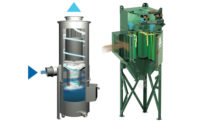The issue of combustible dust and its associated hazards (fire, deflagration, explosion) has always existed in several industries in one form or another. Only recently has the topic of combustible dust has become one of the main concerns and focal points in safety and health. In the past, most safety and health professionals perceived combustible dust hazards as low priority and low risk. Even so, this perception vastly changed after several high-profile combustible dust accidents/fatalities and increased enforcement of combustible dust hazards by the OSHA.
High-profile incidents
In the past decade, several highly publicized combustible dust accidents and fatalities have occurred including, but not limited to these incidents:
• On January 29, 2003, an explosion and fire destroyed the West Pharmaceutical Services plant in Kinston, North Carolina, causing six deaths, dozens of injuries, and hundreds of job losses. The facility produced rubber stoppers and other products for medical use. The fuel for the explosion was a fine plastic powder, which accumulated above a suspended ceiling over a manufacturing area at the plant and ignited.1
• On February 20, 2003, an explosion and fire damaged the CTA Acoustics manufacturing plant in Corbin, Kentucky, killing seven workers. The facility produced fiberglass insulation for the automotive industry. Chemical Safety Board (CSB) investigators determined the explosion was fueled by resin dust accumulated in a production area, likely ignited by flames from a malfunctioning oven. The resin involved was a phenolic binder used in producing fiberglass mats.2
• On the evening of October 29, 2003, a series of explosions severely burned two employees, injured a third, and caused property damage to the Hayes Lemmerz manufacturing plant in Huntington, Indiana. One of the severely burned employees subsequently died. The Hayes Lemmerz plant manufactured cast aluminum automotive wheels, and the explosions were fueled by accumulated aluminum dust, a flammable by-product of the wheel production process.3
The most publicized and scrutinized combustible dust accident/fatality in the United States occurred on February 7, 2008, at the Imperial Sugar Company located in Port Wentworth, Georgia. The vast amounts of sugar dust accumulated throughout the facility caused fires and several violent explosions that ultimately caused 14 deaths and 38 injuries. The explosion at Imperial Sugar caused all safety and health professionals in every industry to re-examine the potential hazards posed by combustible dusts.
Cause for alarm
Although combustible dust hazards are now more widely recognized, combustible dust accidents and fatalities continue to occur. On January 20, 2014, one or more grain dust explosions at the International Nutrition facility located in Omaha, Nebraska, killed two employees and injured at least ten employees4. On August 2, 2015 one or more metal dust explosions at a wheel hub cleaning facility located in Kunshan, China, killed 69 employees and injured at least 200 employees5. These combustible dust accidents and fatalities will continue to occur because combustible dust hazards are frequently underestimated and poorly understood by both employers and employees.
OSHA’s national emphasis program
On October 18, 2007, OSHA initiated the Combustible Dust National Emphasis Program (CPL 03-00-006). On March 11, 2008, OSHA reissued the Combustible Dust National Emphasis Program (CPL 03-00-008) to increase its enforcement activities and to focus on specific industry groups that have experienced either frequent combustible dust incidents or combustible dust incidents with catastrophic consequences6. Since its inception, OSHA’s Combustible Dust National Emphasis Program (NEP) has increased the number and severity of OSHA combustible dust citations. The increased examination and enforcement of combustible dust hazards by OSHA has not only surprised most employers, but also forced employers to question how to adequately identify and address combustible dust hazards.
Myth: Sampling strategies are unnecessary for combustible dusts
In order to properly assess and mitigate potential fire, deflagration, and/or explosion hazards, one must know the specific physical characteristics (particle size, moisture content, etc.) and properties (combustibility, ignition, etc.) associated with the combustible dust(s). The majority of facility operators know the importance of the Kst value and the maximum pressure (Pmax) value of a combustible dust. However, the properties of a combustible dust go far beyond how combustible a dust is (Kst value), or the amount of pressure released during a deflagration (Pmax value).
There is a common misconception that historical data listed in consensus standards and other scientific sources can be used in lieu of testing specific samples of dust that are generated, conveyed, processed, etc., throughout facilities.
Myth: Explosion protection and prevention systems for enclosures are easily designed
Deflagration and/or explosion hazards exist in several types of process machinery and equipment including, but not limited to dust collectors, silos, pulverizers, mixers and screeners (sieves). One of the most common ways to address these hazards is through explosion protection and/or prevention systems (i.e. engineering controls) such as deflagration venting or explosion suppression systems.
A common misconception is that any engineer, safety and health professional, equipment manufacturer, etc., can simply apply the requirements listed in specific standards (NFPA 68, NFPA 69, etc.) to design a system that will adequately control or eliminate the deflagration and explosion hazards associated with the specified combustible dust(s).
But each of these combustible dust explosion protection and/or prevention systems is extremely complex to design, install and maintain correctly. Plus, the physical properties associated with a specific combustible dust are complex and cannot be fundamentally applied to one type of combustible dust. For example, Kst values for wood dusts vary widely and a standardized Kst value that can be applied to all types of wood dusts does not exist. It is imperative that whoever tries to mitigate these deflagration or explosion hazards possesses a thorough knowledge of the properties and hazards associated with the specified combustible dust(s) and processes to be protected.
Summary
The complex fire, deflagration and explosion hazards associated with combustible dusts are prevalent throughout many industries. Only a few of the common myths and mistakes associated with combustible dust were discussed in this article; many more exist. All of these myths and mistakes cause inadequate and ineffective hazard identification, assessment and mitigation that could increase the severity and probability of combustible dust hazards and incidents.
It is vitally important to understand not only all of the characteristics and properties of a combustible dust, but also all of the techniques and methods that can be employed to control or eliminate combustible dust hazards.
References
1. Chemical Safety Board. West Pharmaceutical Services Dust Explosion and Fire (http://www.csb.gov/investigations/detail.aspx?SID=36&Type=2&pg=1&F_AccidentTypeId=1)
2. Chemical Safety Board. CTA Acoustics Dust Explosion and Fire (http://www.csb.gov/investigations/detail.aspx?SID=35&Type=2&pg=1&F_AccidentTypeId=1)
3. Chemical Safety Board. Hayes Lemmerz Dust Explosion and Fire (http://www.csb.gov/investigations/detail.aspx?SID=33&Type=2&pg=1&F_AccidentTypeId=1)
4. Omaha World-Herald. “Evidence Suggests Blast Caused International Nutrition Accident” (http://www.omaha.com/article/20140126/NEWS/140128945/1707)
5. Fox News. “Dust Explosion at Car Parts Factory in Eastern China Kills 69 People, Injures Nearly 200” (http://www.foxnews.com/world/2014/08/03/dust-explosion-at-car-parts-factory-in-eastern-china-kills-6-people-injures/)
6. OSHA. Combustible Dust National Emphasis Program (CPL 03-00-008) (http://www.osha.gov/pls/oshaweb/owadisp.show_document?p_table=DIRECTIVES&p_id=3830)



